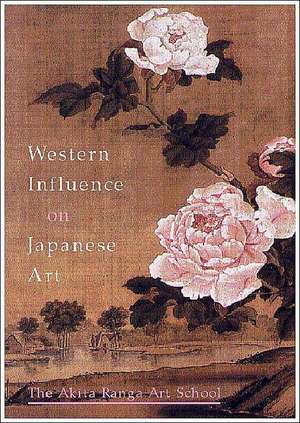Western Influences on Japanese Art: The Akita Ranga Art School and Foreign Books
Autor Hiroko Johnsonen Limba Engleză Hardback – 31 dec 2004
Preț: 477.05 lei
Preț vechi: 561.24 lei
-15% Nou
Puncte Express: 716
Preț estimativ în valută:
91.31€ • 95.16$ • 76.01£
91.31€ • 95.16$ • 76.01£
Carte indisponibilă temporar
Doresc să fiu notificat când acest titlu va fi disponibil:
Se trimite...
Preluare comenzi: 021 569.72.76
Specificații
ISBN-13: 9789074822640
ISBN-10: 9074822649
Pagini: 176
Dimensiuni: 199 x 275 x 20 mm
Greutate: 0.93 kg
Editura: Brill
Colecția Brill | Hotei
ISBN-10: 9074822649
Pagini: 176
Dimensiuni: 199 x 275 x 20 mm
Greutate: 0.93 kg
Editura: Brill
Colecția Brill | Hotei
Notă biografică
Hiroko Johnson is currently Assistant Professor at San Diego State University where she teaches Japanese Art History. She has written numerous articles in Japanese and English on Ito Jakuchu, Shen Nanpin, the artistry of basket makers and the Akita Ranga school.
Descriere
The Akita Ranga art school is a by-product of rangaku, ‘Dutch learning’, an important intellectual movement in eighteenth-century Japan. Akita Ranga artists, highly influenced by illustrations in Western books, created a new direction in Japanese art by using Western techniques such as chiaroscuro (shading) and perspective.
Odano Naotake (1750-80), a leading Akita Ranga artist, illustrated Kaitai shinsho, Japan's first anatomy book. Dr. Johnson first analyses how Naotake applied new techniques to traditional Japanese art and created a quasi-Western style of painting. Secondly, she focuses on Lord Satake Shozan (1748-85), who wrote Japan's first art theory and criticism on Western art and whose complete text is translated and incorporated in this book. Shozan also based his three sketchbooks on foreign books, especially the Schouwtoneel der Natuur by Noel A. Pluche, and wrote an encyclopaedia of scientific lore. By focusing on the influence of illustrations in foreign books, Johnson brings a new perspective to Japanese art history.
Odano Naotake (1750-80), a leading Akita Ranga artist, illustrated Kaitai shinsho, Japan's first anatomy book. Dr. Johnson first analyses how Naotake applied new techniques to traditional Japanese art and created a quasi-Western style of painting. Secondly, she focuses on Lord Satake Shozan (1748-85), who wrote Japan's first art theory and criticism on Western art and whose complete text is translated and incorporated in this book. Shozan also based his three sketchbooks on foreign books, especially the Schouwtoneel der Natuur by Noel A. Pluche, and wrote an encyclopaedia of scientific lore. By focusing on the influence of illustrations in foreign books, Johnson brings a new perspective to Japanese art history.
